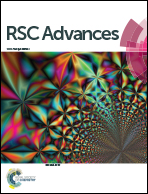Facile microwave-assisted synthesis of In2O3 nanocubes and their application in photocatalytic degradation of tetracycline
Abstract
Novel In2O3 nanocube photocatalysts were successfully prepared by a facile microwave-assisted synthesis method. The obtained products are nano-sized with square corners and high crystallinity. The In2O3 nanocubes possessed high efficiency of electron–hole separation, resulting in high photocatalytic activities for the degradation of tetracycline under both visible light (λ > 420 nm) and full-range light irradiation (360–760 nm), the ratios of which are 39.3% and 61.0%, respectively. Moreover, the calculated positions of the CB and VB under our experimental conditions at the point of zero for In2O3 nanocubes are −0.60 V and +2.17 V, respectively. Note that the redox potentials of [O2/·O2−] and [·OH/OH−] are −0.33 V and +2.38 V, respectively, which means that the irradiated In2O3 nanocubes can reduce O2 into ·O2− without oxidizing OH− into ·OH. It can be concluded that ·O2− and h+ are the main active species of In2O3 in aqueous solution under visible light irradiation and full-range light irradiation.



 Please wait while we load your content...
Please wait while we load your content...